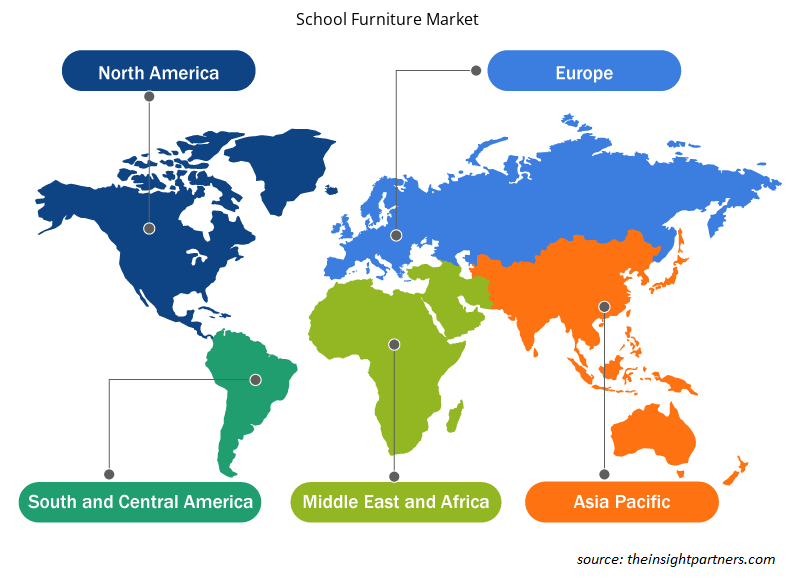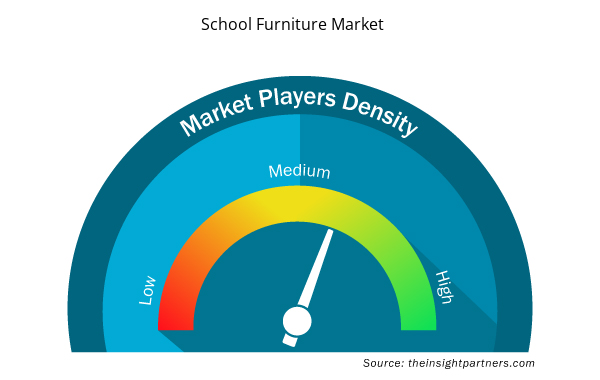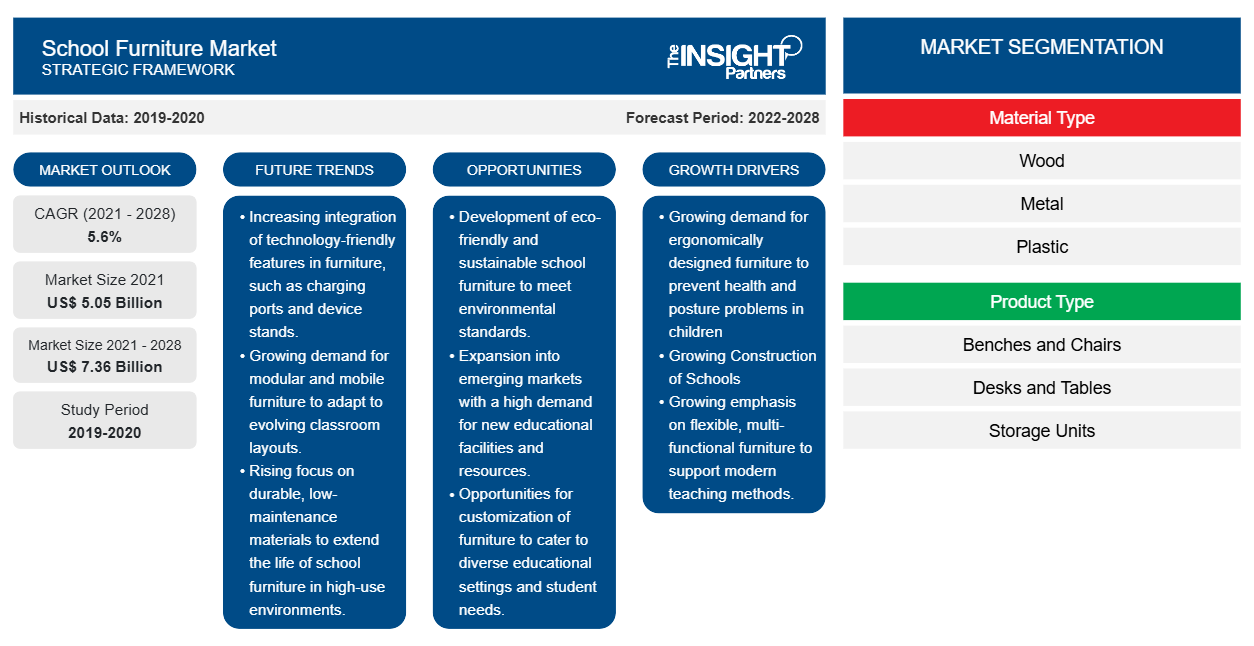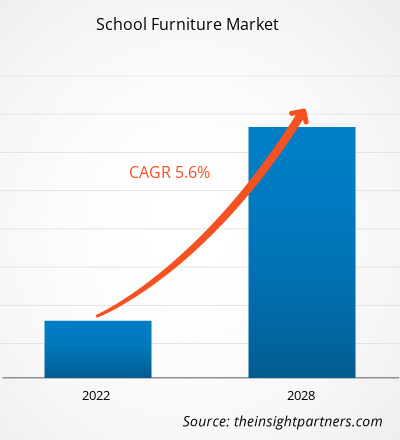[Rapporto di ricerca] Il mercato globale degli arredi scolastici è stato valutato a 5.047,95 milioni di dollari nel 2021; si prevede che crescerà a un CAGR del 5,6% dal 2022 al 2028.
L'arredamento scolastico che comprende librerie, armadietti, credenze, bacheche, scrivanie, sedie, schedari e armadietti di stoccaggio e attrezzature di laboratorio è realizzato utilizzando materiali robusti, facili da usare e di alta qualità, come legno, metalli, pannelli in fibra a media densità (MDF) e plastica. L'arredamento scolastico è progettato in modo da garantire sia il benessere fisico che mentale, consentendo agli studenti di concentrarsi sugli studi con pieno potenziale. Aiuta inoltre a migliorare la flessibilità e la produttività complessiva sia degli insegnanti che degli studenti, trasformando al contempo lo spazio fisico in un ambiente di apprendimento dinamico.
La crescente domanda di mobili progettati ergonomicamente per prevenire problemi di salute e postura nei bambini è il fattore chiave che guida il mercato. Creare ambienti di apprendimento che mantengano gli studenti concentrati e comodi è diventato uno degli obiettivi principali degli educatori, influenzando così positivamente il mercato globale dei mobili scolastici . Con la nuova era di stili di insegnamento completi, interattivi e dinamici come l'apprendimento misto e le aule capovolte, sono diventati necessari mobili portatili e regolabili con facile riconfigurazione.
Personalizza questo report in base alle tue esigenze
Riceverai la personalizzazione gratuita di qualsiasi report, comprese parti di questo report, o analisi a livello nazionale, pacchetto dati Excel, oltre a usufruire di grandi offerte e sconti per start-up e università
- Scopri le principali tendenze di mercato in questo rapporto.Questo campione GRATUITO includerà analisi di dati che spaziano dalle tendenze di mercato alle stime e alle previsioni.
Inoltre, vengono introdotte diverse materie prime per la produzione di mobili, e questi materiali distinti hanno dimostrato di essere più sostenibili, durevoli e stabili di quelli tradizionali, aggiungendo così impulso alla crescita del mercato. I produttori utilizzano materiali come legno lavorato o ingegnerizzato, plastica stampata e laminato ad alta pressione per realizzare panche, sedie e tavoli per aule e scuole. I mobili con opzioni di archiviazione aggiuntive fungono da tattica salvaspazio nelle aule più piccole e compatte, e la domanda per gli stessi ha registrato un aumento significativo negli ultimi anni. Ad esempio, CBT Supply Dba Smartdesks produce tavoli e sedie intelligenti con opzioni impilabili e applicazioni multifunzionali per aule e uffici. Quindi, la crescente domanda di mobili flessibili stimolerà la crescita del mercato nel periodo di previsione.
Approfondimenti di mercato
Crescente costruzione di scuole
Si prevede che la costruzione di scuole in tutto il mondo aumenterà, a causa della rapida crescita della popolazione. La crescente attenzione al settore educativo nelle aree urbane e rurali e i programmi di istruzione primaria obbligatoria forniti dai governi di tutto il mondo stanno spingendo la crescita della costruzione di scuole. Secondo il Center on Budget and Policy Priorities, nel 2018, circa 98,9 miliardi di dollari USA in Nord America sono stati spesi per progetti infrastrutturali per l'istruzione, il che indica un aumento della spesa di quasi il 10% rispetto al 2017. Con l'aumento delle strutture scolastiche, le aule sovraffollate, i cambiamenti nei codici di sicurezza degli edifici e i progressi tecnologici a livello globale, i funzionari si trovano di fronte al dilemma se investire in nuove infrastrutture o aggiornare quelle esistenti. I governi e le società di tutto il mondo si stanno impegnando per sviluppare i loro sistemi educativi e garantire che tutti gli studenti abbiano l'opportunità di andare a scuola e acquisire le competenze e le conoscenze necessarie per condurre una vita produttiva e sana. Per migliorare la qualità dell'istruzione, le infrastrutture educative dovrebbero essere aggiornate.
Inoltre, la crescita delle iscrizioni di studenti in tutto il mondo ha aumentato la domanda di tavoli e sedie per le aule, poiché sono necessari per il funzionamento della scuola. Un aumento nell'adozione di materie prime non convenzionali per l'arredamento delle aule sta portando a ristrutturazioni, collaborazioni e mobili ergonomici per le aule. Diverse scuole stanno progressivamente sostituendo i tradizionali mobili scolastici con infrastrutture esteticamente accattivanti per rendere piacevole l'ambiente delle aule. L'introduzione di sedie girevoli con caratteristiche ergonomiche è stata un'aggiunta recente in molte scuole.
Informazioni sul tipo di materiale
In base al tipo di materiale, il mercato dell'arredamento scolastico è segmentato in legno, metallo, plastica e altri. Nel 2021, il segmento del legno ha dominato il mercato dell'arredamento scolastico.
Fleetwood Furniture; Herman Miller, Inc; KI; Steelcase Inc.; Virco, Inc.; Scholar Craft; Global Furniture Group; Educan; Ven-Rez; e Mitybilt sono tra i principali attori che operano nel mercato dell'arredamento scolastico. I principali attori stanno adottando varie strategie, come fusioni e acquisizioni e lanci di prodotti, per espandere la loro presenza geografica e la base di consumatori.
Segnala i riflettori
- Tendenze progressive nel settore dell'arredo scolastico per aiutare gli operatori a sviluppare strategie efficaci a lungo termine
- Strategie di crescita aziendale adottate dalle aziende per garantire la crescita nei mercati sviluppati e in via di sviluppo
- Analisi quantitativa del mercato degli arredi scolastici dal 2021 al 2028
- Stima della domanda di mobili scolastici nei vari settori
- Analisi PEST per analizzare i cambiamenti politici, economici, socio-culturali e tecnologici nell'ambiente aziendale
- Sviluppi recenti per comprendere lo scenario competitivo del mercato e la domanda di arredi scolastici
- Tendenze e prospettive del mercato, insieme ai fattori che guidano e frenano la crescita del mercato dell'arredo scolastico
- Strategie che sostengono l'interesse commerciale per quanto riguarda la crescita del mercato dell'arredo scolastico, aiutando nel processo decisionale
- Le dimensioni del mercato degli arredi scolastici nei vari nodi del mercato
- Panoramica dettagliata e segmentazione del mercato degli arredi scolastici, nonché delle dinamiche del settore
"School Furniture Market Forecast to 2028" è uno studio specializzato e approfondito del settore chimico e dei materiali, incentrato sull'analisi delle tendenze del mercato degli arredi scolastici. Il rapporto mira a fornire una panoramica del mercato con una segmentazione dettagliata del mercato. Il mercato degli arredi scolastici è categorizzato in base al tipo di materiale, al tipo di prodotto e al canale di distribuzione. In base al tipo di materiale, il mercato è segmentato in legno, metallo, plastica e altri. In base al tipo di prodotto, il mercato è biforcato in residenziale e commerciale e industriale. In termini di canale di distribuzione, il mercato è suddiviso in negozi specializzati, vendita al dettaglio online e contratti/offerte.
Approfondimenti regionali sul mercato dell'arredamento scolastico
Le tendenze regionali e i fattori che influenzano il mercato dell'arredamento scolastico durante il periodo di previsione sono stati ampiamente spiegati dagli analisti di Insight Partners. Questa sezione discute anche i segmenti e la geografia del mercato dell'arredamento scolastico in Nord America, Europa, Asia Pacifico, Medio Oriente e Africa e Sud e Centro America.

- Ottieni i dati specifici regionali per il mercato degli arredi scolastici
Ambito del rapporto sul mercato dell'arredamento scolastico
| Attributo del report | Dettagli |
|---|---|
| Dimensioni del mercato nel 2021 | 5,05 miliardi di dollari USA |
| Dimensioni del mercato entro il 2028 | 7,36 miliardi di dollari USA |
| CAGR globale (2021 - 2028) | 5,6% |
| Dati storici | 2019-2020 |
| Periodo di previsione | 2022-2028 |
| Segmenti coperti | Per tipo di materiale
|
| Regioni e Paesi coperti | America del Nord
|
| Leader di mercato e profili aziendali chiave |
|
Densità degli attori del mercato dell'arredo scolastico: comprendere il suo impatto sulle dinamiche aziendali
Il mercato dell'arredamento scolastico sta crescendo rapidamente, spinto dalla crescente domanda degli utenti finali dovuta a fattori quali l'evoluzione delle preferenze dei consumatori, i progressi tecnologici e una maggiore consapevolezza dei vantaggi del prodotto. Con l'aumento della domanda, le aziende stanno ampliando le loro offerte, innovando per soddisfare le esigenze dei consumatori e capitalizzando sulle tendenze emergenti, il che alimenta ulteriormente la crescita del mercato.
La densità degli operatori di mercato si riferisce alla distribuzione di aziende o società che operano in un particolare mercato o settore. Indica quanti concorrenti (operatori di mercato) sono presenti in un dato spazio di mercato in relazione alle sue dimensioni o al valore di mercato totale.
Le principali aziende che operano nel mercato dell'arredo scolastico sono:
- Mobili Fleetwood
- Azienda
- Io sono
- Azienda
- Virco, Inc.
Disclaimer : le aziende elencate sopra non sono classificate secondo un ordine particolare.

- Ottieni una panoramica dei principali attori del mercato dell'arredamento scolastico
Profili aziendali
- Mobili Fleetwood
- Herman Miller, Inc
- Io sono
- Azienda
- Virco, Inc.
- Artigianato accademico
- Gruppo di mobili globali
- Educatore
- Ven-Rez
- Mitilo
- Analisi storica (2 anni), anno base, previsione (7 anni) con CAGR
- Analisi PEST e SWOT
- Valore/volume delle dimensioni del mercato - Globale, regionale, nazionale
- Industria e panorama competitivo
- Set di dati Excel



Report Coverage
Revenue forecast, Company Analysis, Industry landscape, Growth factors, and Trends

Segment Covered
This text is related
to segments covered.

Regional Scope
North America, Europe, Asia Pacific, Middle East & Africa, South & Central America

Country Scope
This text is related
to country scope.
Domande frequenti
The major players operating in the global school furniture market are Fleetwood Furniture; Herman Miller, Inc; KI; Steelcase Inc.; Virco, Inc.; Scholar Craft; Global Furniture Group; Educan; Ven-Rez; and Mitybilt.
In 2021, North America held the largest share of the global school furniture market. The rise in the educational infrastructure would cater the demand of school furniture in the region. The region is also flourishing owing to presence of manufacturing facilities.
The wood segment held the largest market share. Wooden furniture is the most popular in schools, owing to the high manufacturing output of wooden products in comparison to other materials. Moreover, wood is conventionally looked at as the most preferred material for furniture production.
The benches and chairs segment held the largest market share. School chairs vary in design and are primarily made of wood, metal, and synthetic plastic materials. Folding chairs, rocking chairs, loungers, and many others are quite popular among customers.
Asia Pacific is estimated to register the fastest CAGR in the global school furniture market over the forecast period. Many Asia Pacific countries, such as China and India, are the world's fastest-growing populations. With a growing population construction and school furniture material are growing rapidly in Asia Pacific.
The contracts/bids segment held the largest share of the market in 2021. Most of the schools organize bids for school furniture. The companies can be given a contract for vendor ship, replacement, or repair based on the contract signed between the schools and them.
Trends and growth analysis reports related to Consumer Goods : READ MORE..
The List of Companies - School Furniture Market
- Fleetwood Furniture
- Herman Miller, Inc.
- KI
- Steelcase Inc.
- Virco, Inc.
- Scholar Craft
- Global Furniture Group
- Educan
- Ven-Rez
- Mitybilt
The Insight Partners performs research in 4 major stages: Data Collection & Secondary Research, Primary Research, Data Analysis and Data Triangulation & Final Review.
- Data Collection and Secondary Research:
As a market research and consulting firm operating from a decade, we have published and advised several client across the globe. First step for any study will start with an assessment of currently available data and insights from existing reports. Further, historical and current market information is collected from Investor Presentations, Annual Reports, SEC Filings, etc., and other information related to company’s performance and market positioning are gathered from Paid Databases (Factiva, Hoovers, and Reuters) and various other publications available in public domain.
Several associations trade associates, technical forums, institutes, societies and organization are accessed to gain technical as well as market related insights through their publications such as research papers, blogs and press releases related to the studies are referred to get cues about the market. Further, white papers, journals, magazines, and other news articles published in last 3 years are scrutinized and analyzed to understand the current market trends.
- Primary Research:
The primarily interview analysis comprise of data obtained from industry participants interview and answers to survey questions gathered by in-house primary team.
For primary research, interviews are conducted with industry experts/CEOs/Marketing Managers/VPs/Subject Matter Experts from both demand and supply side to get a 360-degree view of the market. The primary team conducts several interviews based on the complexity of the markets to understand the various market trends and dynamics which makes research more credible and precise.
A typical research interview fulfils the following functions:
- Provides first-hand information on the market size, market trends, growth trends, competitive landscape, and outlook
- Validates and strengthens in-house secondary research findings
- Develops the analysis team’s expertise and market understanding
Primary research involves email interactions and telephone interviews for each market, category, segment, and sub-segment across geographies. The participants who typically take part in such a process include, but are not limited to:
- Industry participants: VPs, business development managers, market intelligence managers and national sales managers
- Outside experts: Valuation experts, research analysts and key opinion leaders specializing in the electronics and semiconductor industry.
Below is the breakup of our primary respondents by company, designation, and region:

Once we receive the confirmation from primary research sources or primary respondents, we finalize the base year market estimation and forecast the data as per the macroeconomic and microeconomic factors assessed during data collection.
- Data Analysis:
Once data is validated through both secondary as well as primary respondents, we finalize the market estimations by hypothesis formulation and factor analysis at regional and country level.
- Macro-Economic Factor Analysis:
We analyse macroeconomic indicators such the gross domestic product (GDP), increase in the demand for goods and services across industries, technological advancement, regional economic growth, governmental policies, the influence of COVID-19, PEST analysis, and other aspects. This analysis aids in setting benchmarks for various nations/regions and approximating market splits. Additionally, the general trend of the aforementioned components aid in determining the market's development possibilities.
- Country Level Data:
Various factors that are especially aligned to the country are taken into account to determine the market size for a certain area and country, including the presence of vendors, such as headquarters and offices, the country's GDP, demand patterns, and industry growth. To comprehend the market dynamics for the nation, a number of growth variables, inhibitors, application areas, and current market trends are researched. The aforementioned elements aid in determining the country's overall market's growth potential.
- Company Profile:
The “Table of Contents” is formulated by listing and analyzing more than 25 - 30 companies operating in the market ecosystem across geographies. However, we profile only 10 companies as a standard practice in our syndicate reports. These 10 companies comprise leading, emerging, and regional players. Nonetheless, our analysis is not restricted to the 10 listed companies, we also analyze other companies present in the market to develop a holistic view and understand the prevailing trends. The “Company Profiles” section in the report covers key facts, business description, products & services, financial information, SWOT analysis, and key developments. The financial information presented is extracted from the annual reports and official documents of the publicly listed companies. Upon collecting the information for the sections of respective companies, we verify them via various primary sources and then compile the data in respective company profiles. The company level information helps us in deriving the base number as well as in forecasting the market size.
- Developing Base Number:
Aggregation of sales statistics (2020-2022) and macro-economic factor, and other secondary and primary research insights are utilized to arrive at base number and related market shares for 2022. The data gaps are identified in this step and relevant market data is analyzed, collected from paid primary interviews or databases. On finalizing the base year market size, forecasts are developed on the basis of macro-economic, industry and market growth factors and company level analysis.
- Data Triangulation and Final Review:
The market findings and base year market size calculations are validated from supply as well as demand side. Demand side validations are based on macro-economic factor analysis and benchmarks for respective regions and countries. In case of supply side validations, revenues of major companies are estimated (in case not available) based on industry benchmark, approximate number of employees, product portfolio, and primary interviews revenues are gathered. Further revenue from target product/service segment is assessed to avoid overshooting of market statistics. In case of heavy deviations between supply and demand side values, all thes steps are repeated to achieve synchronization.
We follow an iterative model, wherein we share our research findings with Subject Matter Experts (SME’s) and Key Opinion Leaders (KOLs) until consensus view of the market is not formulated – this model negates any drastic deviation in the opinions of experts. Only validated and universally acceptable research findings are quoted in our reports.
We have important check points that we use to validate our research findings – which we call – data triangulation, where we validate the information, we generate from secondary sources with primary interviews and then we re-validate with our internal data bases and Subject matter experts. This comprehensive model enables us to deliver high quality, reliable data in shortest possible time.


 Ottieni un campione gratuito per questo repot
Ottieni un campione gratuito per questo repot